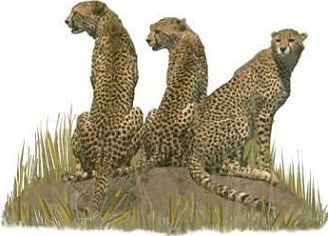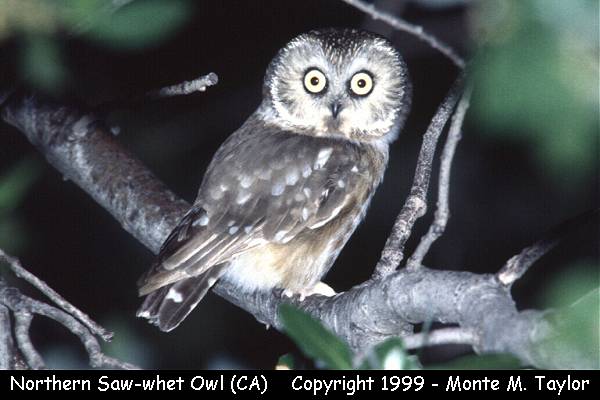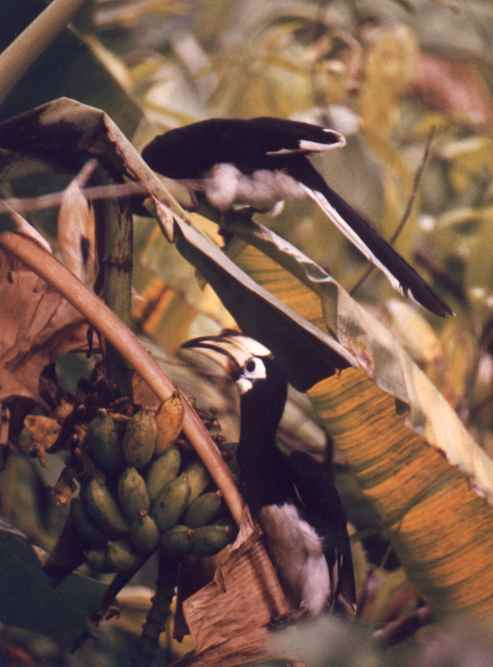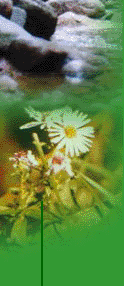|

The Cat (Felidae) Family
lion - tiger - leopard - snow leopard - clouded leopard - cheetah - African golden cat - Asian
golden cat - Andean Mountain cat - black footed cat - bay cat - bobcat - caracal - Chinese mountain cat - cougar - domestic
- fishing cat - flat headed cat -Geoffroys cat - iriomote cat - jaguarundi - jungle cat - kodkod - leopard cat - lynx - marbled
cat - margay - ocelot - oncilla - pallas cat - pampas cat - rusty spotted cat - sand cat - serval - wildcat
Jaguar
:-
The jaguar is the only member of the genus Panthera (big cats) to be found in the Americas where it is considered
the New World equivalent of the leopard. Its coat is basically yellowish-brown but can vary from almost white to black. Its
back is marked with dark rosettes and the lower part of the tail is ringed with black. Jaguars weigh anywhere from 90-120
kg (males) and 60-90 kg (females).
Range: Historically, jaguar ranged from the southern United States through
Central America to Venezuela, the Guianas, and Brazil. The former United States distribution included southern California,
New Mexico, southern Arizona, Texas, and possibly Louisiana and Colorado. Unfortunately, the jaguar is now extinct in Uruguay
and virtually extinct in the United States, most of Mexico and Argentina, and the developed areas of Central and South America.
Current distribution is in a broad belt from central Mexico through Central America and into South America as far south as
the northern portion of Argentina. The last confirmed sighting of a jaguar in the United States, was on March 7, 1996 in New
Mexico's Peloncillo Mountains, about 6 miles from the Mexico border.
Habitat: Jaguar habitat requirements
include dense cover (forest, brush, grass) water, and sufficient prey. In general, they occur in a wide variety of tropical
habitats, ranging from montane forest and wet savannah to tropical rain forest and deciduous tropical forest. They are especially
common near rivers, streams and lagoons and have been known to use roads and trails for travel and hunting.
Diet:
Although known to feed on large prey such as deer, tapir, and peccary, jaguars are opportunistic feeders often feeding on
smaller animals, like capybara, sloths, armadillos, and fish.
Social Organization: Data suggest that jaguars
are predominantly solitary. Unlike other solitary cat species; however, home ranges may occasionally overlap. It is suggested
that in areas of high prey density, jaguars can share limited ranges.
Conservation Status: Despite the historical
lack of precise population estimates, jaguar are known to be rare or extinct in many parts of their former range. Estimates
indicate that the total current wild population is greater than 10,000; however, several subspecies are reported as rare.
The United States population consists of only isolated stray animals crossing the Mexico/U.S. border. Jaguar are listed as
endangered by USDA, Appendix I by CITES and Vulnerable by IUCN.
Threats to Survival: Threats to the jaguar
include habitat loss, hunting, and development throughout their range. Hunting and export are still allowed in some Central
American countries and restrictions in other countries are poorly enforced; even if hunting is prohibited. Loss of forest
habitat is a major concern for the decline of the species as estimates of deforestation rates in Latin America are among the
highest in the world.
Birds :-
Birds are warm-blooded vertebrate animals that have wings, feathers,
a beak, no teeth, and strong, hollow bones.
Most birds can fly. Birds have a very strong heart and an efficient way
of breathing - these are necessary for birds to fly. Birds also use a lot of energy while flying and need to eat a lot of
food to power their flight.
Not all flying animals are birds; bats, pterosaurs, and flying insects are not birds.
Bird locomotion is quite varied; most can fly, some can run very well, some swim, and some do combinations of these.
Some birds cannot fly.
Most birds can fly. Flying birds' wings are shaped to provide lift, allowing them to fly. These
light-weight animals have adapted to their environment by flying, which makes them efficient hunters, lets them escape from
hungry predators (like cats), and takes them away from harsh weather (migration).
The peregrine falcon is one of the
fastest birds, and has been clocked at 90 miles per hour in a dive (and some people say that they can dive at over 200 mph).
Feathers are highly modified scales. There are different types of feathers that have different uses.
Feathers
are used for:
Flying - flight feathers, grow in the wings and the tail.
Thermal insulation - soft down feathers
that grow close to the skin keep birds from getting too cold or too hot
Courtship and mating displays - these vary
tremendously from species to species.
Birds spend most of their time looking for food. Some birds, like owls and eagles,
are carnivores (meat-eaters). Some birds, like the hummingbird, grouse, and Canada goose, are herbivores (plant-eaters). Other
birds, like starlings, are omnivores (plant and meat-eaters).
Birds mostly use their keen eyesight to find food. They
use their beak and their claws to get bugs, worms, small mammals , fish, fruit , grain, or nectar.
Birds play a very
important part in the natural control of insects and in the dispersal of seeds. Some birds, like the tiny, nectar-eating hummingbird
are important pollinators of some flowering plants.
Nesting :-
Birds bear their young in hard-shelled eggs which
hatch after some time. Some birds, like chickens, lay eggs each day, others (like the maleo) may go for years between laying
eggs. The incubation period of bird eggs varies from species to species. There's also some variability due to the temperature.
Some birds, like cuckoos and some cowbirds, lay their eggs in other bird's nests. The non-related adult bird takes care
of the cuckoo's egg unwittingly. Some cuckoos even kill the other eggs in the nest to insure that their egg gets enough food.
Migration:
Many bird species migrate to a cooler climate for reproducing and summer feeding, and then return
to a warmer climate for the winter. It is unknown exactly how birds are able to navigate accurately, but many people are studying
this mystery of how birds know where to fly.
The Classification of Birds:
Birds belong to the biological class
Aves and live virtually everywhere on Earth. Birds are amniotes, animals whose eggs are protected from drying out (a group
that includes the mammals, birds, dinosaurs, and reptiles). There are about 9,000 different species of birds, divided into
24 orders and 146 Families. Most birds alive today are Neognathae (a group distinguished by common palate structure). Another,
much smaller group, is the Palaeognathae (again grouped by palate structure), which include the ostrich, kiwi, emu, rhea,
and others.
The Evolution of Birds:
Birds probably evolved from meat-eating (theropod) dinosaurs during the
Mesozoic Era, roughly 150 million years ago.
Bird Songs:
Birds sing beautiful and diversified songs. Many songbirds
are becoming scarcer every year.
Do Bird Have Knees?
Why Do Their Legs Bend Backwards?
Yes, birds have
knees (they're often under the feathers and not easily visible), and they bend the same way our knees bend. The part of a
bird's legs that bends backwards when it walks is the ankle.
Heart Rate and Breathing:
In order to fly, birds
need a lot of oxygen, which they get by breathing air using lungs. They also need a strong circulatory system, including a
powerful heart in order to circulate the oxygen. A bird's heart beats much faster than our heart does. A hummingbird's heart
beats about 1,000 times each minute; a human's heart beats about 60-90 times each minute.
Birds breath using a unique
system in which air follows a one-way route through the respiratory system. This system is unlike our lungs, in which the
air backtracks where it came from. Their system of respiration (breathing) is very efficient - much more efficient than ours
ststem.
Birds have two relatively small lungs (where gas exchange occurs), but the lungs are augmented by bellows-like
air sacs (where no gas exchange occurs). These air sacs keep the lungs perpetually inflated (even when the bird is exhaling).
Our lungs alternately fill and empty out. The bird's respiratory system takes up 20% of a birds's volume (our respiratory
system takes up only 5% of our volume).
In the bird's respiratory system, air first flows through air sacs (located
even inside their hollow bones) that direct fresh, oxygenated air into the tube-like lungs (parabronchi, where gas exchange
occurs) both when the bird inhales and when it exhales.
This system increases birds' respiratory efficiency and gives
them enough oxygen for flight.
Bird fossils are rare because bird bones are hollow and fragile, but Jurassic, Cretaceous,
Eocene and Miocene-Pliocene bird fossils have been found.
The Archaeopteryx is the oldest known fossil bird,
now extinct. It dates from about 150 million years ago during the late Jurassic period. Although Archaeopteryx had feathers
and could fly, it had similarities to dinosaurs, including its teeth, skull, and certain bone structures.
The
first Archaeopteryx fossilized feather impression was found in 1860 in a limestone quarry in Germany. A year later, a much
more complete fossilized Archaeopteryx was found at the same quarry. Impressions of its feathers and bone structure were quite
clear. More have been found since.
In 1868, Thomas Henry Huxley interpreted the Archaeopteryx fossil to be a
transitional bird having many reptilian features. Along with Compsognathus, a bird-sized and bird-like dinosaur, Huxley argued
that birds and reptiles were descended from common ancestors. Decades later, Huxley's ideas fell out of favor, only to be
reconsidered over a century later (after much research and ado) in the 1970's.
Many birds have become extinct
because of competition for habitat and food, predators, exposure to harmful chemicals, etc. Birds as a group have been in
a gradual decline since they reached a peak about a quarter to a half a million years ago.
EARLY BIRDS
The fossil record of early birds is very incomplete because their bones are so fragile and don't fossilize well. Also,
feathers don't fossilize very well, so no one really knows what these extinct birds looked like; these reconstructions are
based on educated guesses.
Below is a listing of some extinct, early birds.
ARCHAEOPTERYX
Archaeopteryx
(meaning "ancient wing") is a very old prehistoric bird dating from the Jurassic period, about 150 million years
ago. It had teeth, feathers, three claws on each wing, a flat sternum (breastbone), and a long, bony tail.
DIATRYMA
Diatryma were human-sized, heavily-built, flightless birds that date from the Tertiary to the early Eocene (38 million
to 2 million years ago). They were about 7 feet (2.1 m) tall, had thick legs with clawed feet, tiny wings, and huge, powerful,
hooked beaks on a big head. They were probably carnivores (although there is some controversy about this) and perhaps the
top predators in what is now western Europe and North America, in an environment that was a tree-covered plain. They nested
on the ground. The small, fast, carnivorous mammal Cladosictis may have driven it to extinction by eating its eggs and chicks.
Diatryma gigantea was named by paleontologist E.D. Cope in 1876 from a New Mexico fossil. (Subclass Neornithes, Order Gruiformes)
EOALULAVIS
Eoalulavis was the earliest bird that had good maneuverability while flying, even at low speeds
(this extra flight control is obtained from a tuft of feathers on the thumb called the alula - it also helps in takeoffs and
landings). Fossils have been found in Spain.
HESPORNIS
Hespornis (meaning "western bird") was
an early, flightless bird that lived during the late Cretaceous period. This diving bird was about 3 feet (1 m) long and had
webbed feet, a long, toothed beak, and strong legs. Although it couldn't fly, it was probably a strong swimmer and probably
lived near coastlines and ate fish. Fossils have been found in North America .
IBEROMESORNIS
(pronounces
eye-BER-oh-mes-OR-nis) Iberomesornis (meaning "Iberian=Spanish intermediate bird") was a small, early, toothed bird
that lived during the early Cretaceous period. It was capable of powered flight. It had tiny, spiky teeth in its beak and
was the size of a sparrow. Its hip was primitive compared to modern birds; its ilium, ischium, and pubis were all parallel
and directed backward. Iberomesornis was named by paleontologists Sanz and Bonaparte in 1992. Fossils were found in Spain.
The type species is I. romeralli.
ICHTHYORNIS
Ichthyornis (meaning "fish bird") were 8 inch
(20 cm) long, toothed, tern-like, extinct bird that date from the late Cretaceous period. It had a large head and beak. This
powerful flyer is the oldest-known bird that had a keeled breastbone (sternum) similar to that of modern birds. It lived in
flocks nesting on shorelines, and hunted for fish over the seas. Ichthyornis was originally found in 1872 in Kansas, USA,
by a member of paleontologist Othniel C. Marsh's Yale University expedition. Fossils have been found in Kansas and Texas,
USA and Alberta, Canada. (Subclass Odontornithes, Order Ichthyornithiformes)
MONONYKUS
(pronounced mon-NON-i-kus)
Mononykus (meaning "single claw") was a small, insect-eater from the Late Cretaceous period, about 72 million years
ago. Mononykus was either a bird-like dinosaur (an advanced theropod) or a primitive bird; it possessed qualities of both
groups of animals, and there is much scientific debate over which it is. Mononykus had short arms with one long, thick clawed
finger on each hand (hence its name). It was lightly built, had long, thin legs, and a long tail. Mononykus was roughly 28
inches (70 cm long). A fossil was found in SW Mongolia in 1923 (and originally called Mononychus). Mononykus was named by
Perle, Norell, Chiappe, and Clark in 1993. The type species is M. olecranus.
PATAGONYKUS
(pronounced pat-ah-GONE-eh-kus)
Patagonykus (meaning "Patagonia claw") was a lightly-built meat-eater with a single, clawed finger on each hand.
It was about 6.5 ft (2 m) long. It had long legs, a long tail, and short arms. Patagonykus lived during the late Cretaceous
period, about 90 million years ago. Patagonykus was either a bird-like dinosaur (an advanced theropod) or a primitive bird;
it possessed qualities of both groups of animals, and there is much scientific debate over which it is. Patagonykus was similar
to Mononykus. Fossils were found in Patagonia, a region of southern Argentina. The type species is P. puertai. Patagonykus
was named by paleontologist F. Novas in 1996.
PHORORHACOS
Phororhacos is a genus of long-extinct flightless
birds that were about 5 feet (1.5 m) long. It had long, sturdy legs, short wings, a large skull, a large, heavy body and a
large beak. This carnivore may have eaten small mammals, probably killing them with its beak and legs. It looked like an ostrich
with a larger head. It lived during the Oligocene Epoch, about 30 million years ago. Fossils have been found in Patagonia,
South America. (Subclass Neornithes, Order Gruiformes) PROTOAVIS
Protoavis (meaning "first bird") is an extinct
diapsid from the late Triassic period (80 million years earlier than Archaeopteryx). Its partly toothless jaw and keel-like
breast bone were like those of birds. It also had a tail, dinosaur-like rear legs, and hollow bones. There is some dispute
about whether this animal was a bird or a dinosaur; the answer depends partly on whether the Protoavis fossil belongs to one
or two different genera. Fossils have been found in Texas, USA. TERATORNIS
Teratornis (meaning "monster bird")
was an early condor-like bird. This giant, extinct predator had a wingspan of roughly 16-25 feet (5-7.6 m). This carnivore
(meat-eater) dates from the Pleistocene epoch, about 1.8-.01 million years ago. Classification: Class Aves, Order Ciconiformes,
Family Teratornithidae (teratornis), Genus Teratornis, species merriami and incredibilis.
Birds build nests
for breeding in trees, on cliffs, or on the ground. Most birds are taken care of by at least one parent until they are able
to fly and get their own food.

Owls :-
Owls are classified as belonging to the order Strigiformes, a group which is most closely related to nightjars,
cuckoos, and swifts. The order is divided into two families: Tytonidae or Barn Owls and related species, of which there are
up to 18 species known, and Strigidae, to which the remaining 108-194 Owl species belong.
Look into the face of any Owl
and you will be left in little doubt that vision is important to these birds. Huge staring eyes will fix their gaze upon you,
giving the bird an air of benign wisdom or malevolent hatred, depending on the Owl's mood. The eyesight of Owls is legendary,
particularly their ability to see in near darkness. Recent studies have shown, however, that their vision is not quite as
acute as was once supposed. It would appear, in fact, that the Owl's vision and hearing work in harmony. An Owl's eyes are,
in effect, fixed in their sockets. They face forward and provide a wide angle of vision, the overlapping field of view providing
binocular, stereoscopic vision. Having eyes fixed in their sockets could prove a disadvantage when it comes to scanning the
surroundings. To compensate for this, Owls have incredibly flexible necks that enable the birds to rotate their heads 270
degrees in either direction, or even turn them upside down.The eyes are also adapted for seeing at low light intensities,
with large pupils and a retina (the layer of light-receptive cells at the back of the lens) endowed with a greater proportion
of cells than diurnal birds. These extremely sensitive cells, called rods, enable the Owl to see only in monochrome. Although
Owls' eyes are undoubtedly more acute at low light levels than our own, it is probably only by a factor of three or four times
that they differ. An Owl's eyes are protected by a nictitating membrane which can be closed at will. The motion of the membrane
removes dust and debris from the surface of the eye.The ears of an Owl are concealed by feathering at the margins of the facial
disc. The openings of the ears are very large and they are also placed asymmetrically - one higher than the other when the
Owl's face is viewed head on. This heightens the bird's ability to pinpoint a sound source, both in terms of direction and
of distance.
All Owls have relatively long legs and large feet which are equipped with fearsome talons. It is these
that enable the bird to capture the prey; the grip and the piercing bite of the talons are often enough to deliver a fatal
blow along with the first strike. Under normal circumstances three toes are carried facing forward with one facing backward,
and this is sufficient for perching. At times, however, the outer toe can be reversed and this greatly enhances the prey-capturing
capability of the feet. Like diurnal birds of prey, all Owls have a long, hook-tipped beak. This is sometimes used to kill
prey held in the talons, but is more often used to carry prey in flight or to tear portions off larger quarry prior to swallowing
or feeding to young. Much of the beak is concealed by feathering and therefore can appear quite small. When opened wide for
swallowing, however, a huge gape is revealed, more than enough for most Owl species to swallow a small mammal whole.
Many Owl species, even surprisingly large-sized ones, feed almost exclusively on small mammals, and this is clearly the
feeding strategy that suits the group as a whole. There are, however, a number of notable exceptions. Many of the smaller
Owls, especially those from warmer climates, specialise in catching insects while, at the other extreme, Eagle Owls have been
known to tackle prey the size of a small deer. Perhaps the most unusual diet is found in the Fishing Owls and Fish Owls which,
as their names relate, capture fish. Among the diurnal birds of prey some species, notably vultures, have specialised in feeding
on carrion. There are no Owls that have adopted this way of life. Most Owls feed almost exclusively on the prey to which they
are best adapted and show little variation in their feeding preferences. However, species which have a particularly wide global
distribution are sometimes more adaptable. Owls hunt in two primary ways. Species such as Barn Owls and Short-eared Owls often
quarter areas of grass with slow, buoyant flight, looking and listening for the movements of rodents below. Others, such as
the forest-dwelling species, prefer to perch motionless on a lookout branch, watching and listening for the tell-tale signs
of prey below. Larger species of Owls often swallow their prey whole or divide it into more-or-less intact portions. The food
is eaten, but the bones, fur or feathers of the victims are indigestible. From time to time Owls regurgitate pellets containing
said matter, and this frequent function is often performed at a regular site. Pellets can, therefore, be collected and a good
assessment of the Owl's diet can be made. In order to examine a pellet, soak it for a short while in water before teasing
it apart.

Hornbill :-
The most interesting part of the hornbill's life cycle is the unusual way in which the adults raise
their young. In the summer months the pair will seek out a natural nesting hole in the trunk or branch of a large tree. After
mating (usually in October/November in this area), the female enters the hole and lays 3 - 4 eggs. During this time, the male
will bring mud and packing material to the female and she proceeds to seal the hole from the inside, leaving only a very small
longitudinal slit. She then moults all her primary and tail feathers and in this semi-naked state begins to brood the eggs.
Brooding usually lasts for a period of 24 days.
The male flies backward and forward, ferrying insects to the female,
and when the young hatch, his workload becomes exhausting. Eventually, approximately 20-22 days after the first egg has hatched,
the mother breaks down the mud and emerges with newly-grown flight feathers, to help her frantic and exhausted mate feed their
perpetually hungry, squabbling brood. The youngsters then reseal the entrance by themselves. About 44-47 days after they have
hatched, the young hornbills leave the nest.
The advantage of sealing the hole is of course protection from nest-robbing
snakes, birds and even mammals, such as monkeys, baboons and genets. However, should anything happen to the male, the flightless
female and her helpless brood are doomed to a lingering death from starvation.
|




